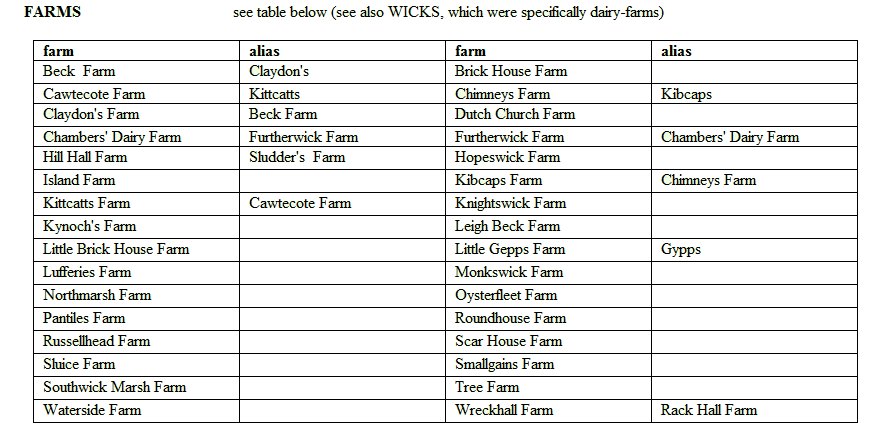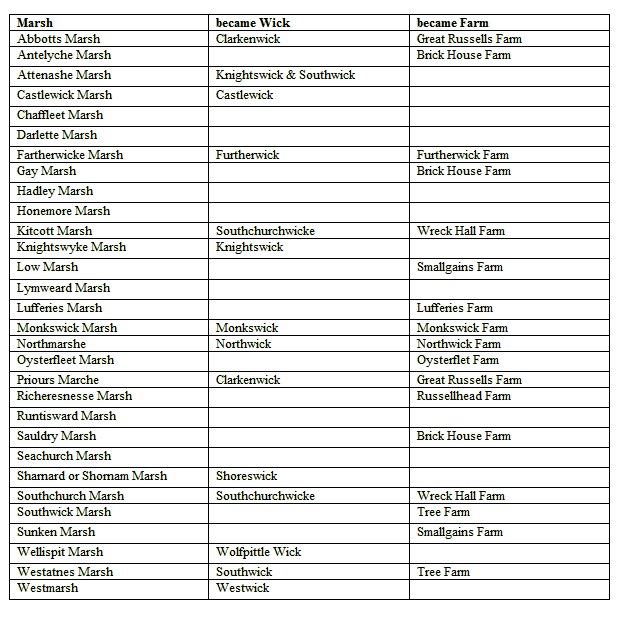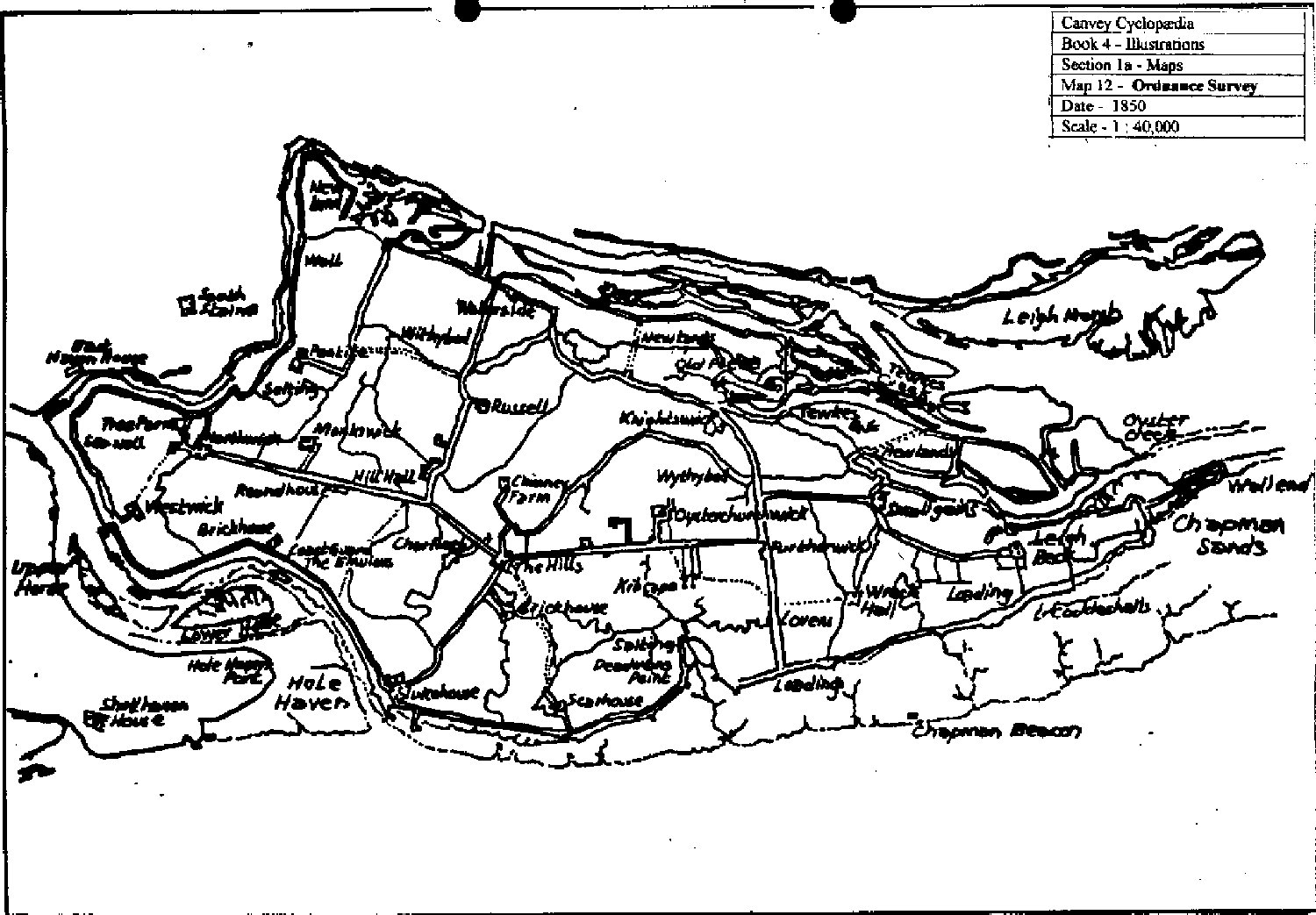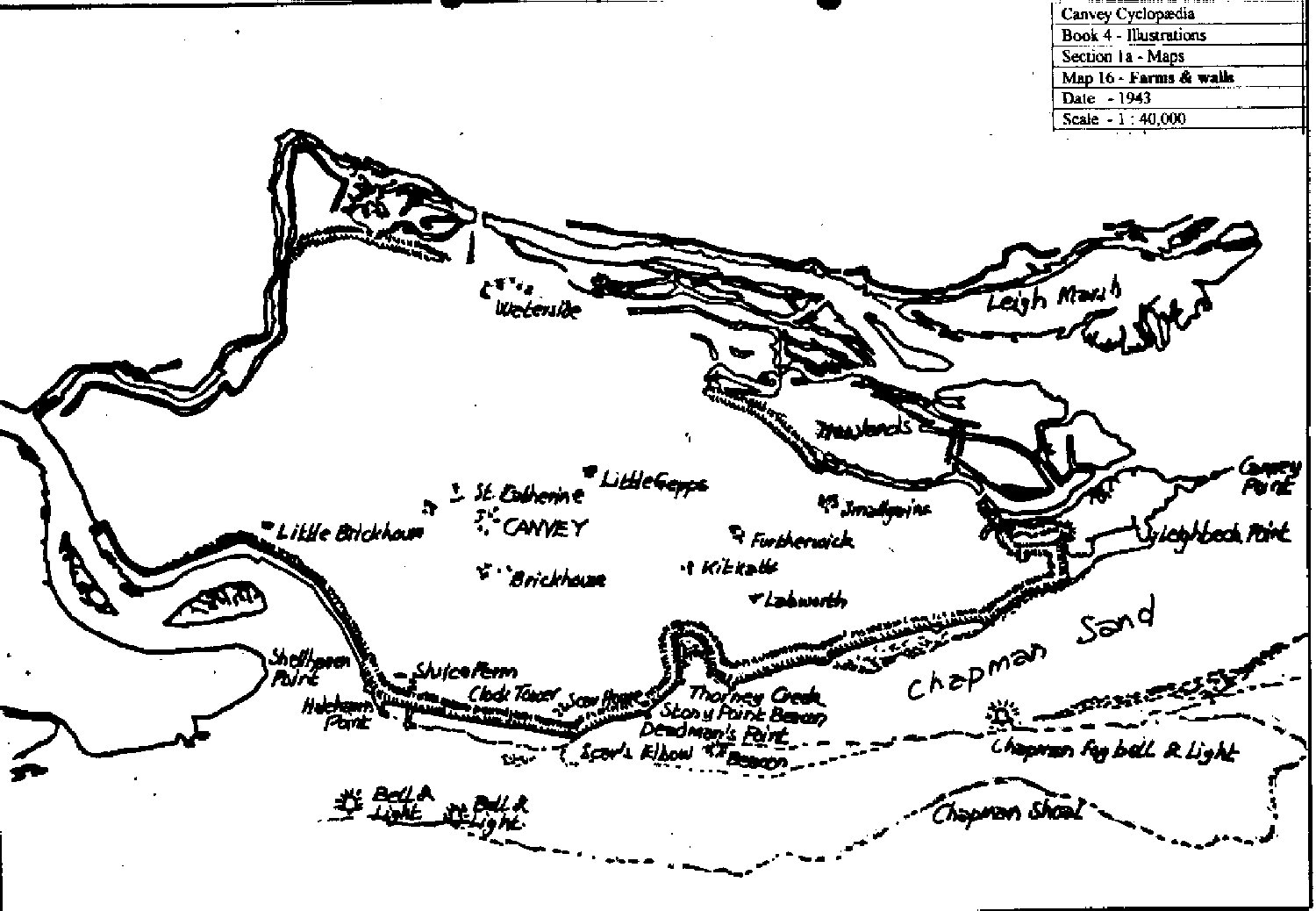I have been looking into Canvey Farms, their names who owned them and who worked them. I must say it is giving me quite a headache.
Dowd’s Cyclopaedia has some diagrams and maps which might help to sort them out.

Dowd’s list of farms and their alias. Some of the farms are also known by their owners name which causes more confusion

- Each farm on Canvey went through three stages & names : i) originally a Marsh, subject to the vagaries of the sea; ii) in Norman times some walling was done to allow the erection of permanent ‘Wicks’ (ewe-milking sheds), later this term was extended to mean the complete dairy farm; iii) after the Dutch wall-building programme allowed cropping, they became fully-fledged (arable) Farms.
Below is a map showing some of the farms. Spellings often differ from document to document. In 1874 Jeps Farm, 1896 Littel Gepps, later known as Little Gypps. There were three’ Tree farms’ one called Tree West, one Tree Middle as well as Tree Farm. Middle Tree was Southwick Farm. Tree West was either Northwick Farm or closeby. Kitkatts Farm can be spelled Kitts Kotts or Kittkatts but it used to be Cawtecote Farm. Lubbins used to be called Lovens farm but it was also later called Labworth Farm. Furtherwick was known as Chambers Farm because the owners name was Chambers. Kipkaps Farm is thought to be Kitkatts Farm as it sometimes shows up on the maps where Kitkatts farm was but it was actually further West, North of the village and its other name was Chimney Farm.
Talking to locals causes even more confusion as they often call the farm by the farmers name as Chambers above. Cooks Farm, as there were more than one area known as Cooks Farm and more than one brother I gave up. Leigh Beck Farm was known as Claydon’s Farm or Clayton’s Farm as the name appears on some documents. It was John ‘Jack’ Claydon who farmed there between 1918/1930s sometime before that it was owned by Frederick Hester.
Some of the names we know today are Brickhouse Farm, Russell Head and Waterside. With many others now just a named area of the Island.
There is a lot more in Dowd’s Canvey Cyclopaedia and I am sure there is a lot more to find out. I hope you have followed this ok and are now clear about Canvey Farms. I still have a headache!!!

O/Survey map from 1850

Map from 1943




Comments about this page
One of the farms that Dowd has not included in his marsh list is Pantile Farm. This was originally Longwick and Longcoat Marsh (NW Canvey) it was known as Pantile Farm by 1774. This is now the RSPB West Canvey Marsh an open to the public where the site of the old farm house can be seen.
Jan, Thanks for mentioning Pantiles Farm and it’s name originating before 1774. The name has always fascinated me because I could see no direct Canvey connection(marsh,wick etc). This has prompted me to do a little research on ‘pantiles’ as roofing material and find that they first appeared in Eastern England in the 17th cent and they were imported from, guess where? Holland! So it would appear our farm was named after it’s roof-tiles which could have arrived on Canvey as imports or more likely as ballast on Dutch eel-boats plying between Holehaven and Holland. P.S. The floor of Furtherwick Farm was reputed to be made of Dutch bricks originally used as ballast.
Thats sorted that then 🙂
The Dutch eel boat is a well ship. The well was filled with water that surrounds the ship, which kept the eel alive. An eel boat had a length of 18.5 meter (60 feet) and a width of 4.5 meter (14.7 feet). The total weight was 60 to 80 tons. They carried 8 to 10 tons of live eel. There was no space for capacity for extra goods like bricks or tiles. On the other hand the eels were collected in the Northern part of the Netherlands (Friesland) and brick and tile production traditionally and still is situated in the center along the big rivers Maas, Waal and Rhine. It isn’t likely that the above mentioned roof-tiles were imported by the eel Boats.
Hi Maurits, Thank you for your well informed comment on the Dutch eel-boats, this certainly does refute what now must seen as a misconception held locally regarding the use of bricks or tiles as ballast. On consideration, my comment to include the eel-boats was rather presumptive as the heyday of them gathering in the nearby Holehaven Creek after unloading at Billingsgate Market was more likely in the latter half of the 19th century, over a hundred years after name of the farm first appeared. Thanks again, Graham. p.s. Are you visiting the Archive site from Holland?
It’s correct, I ‘m visiting the site from Holland. With great pleasure. Especially the photographs, the information of the eel boats and the Lobster Smack Inn. And all the other historic facts concerning the Anglo/Dutch relation of Canvey Island. The eel boats gathered in the Holehaven Creek while they were fully loaded. They still had to go to Billingsgate. Around 1826 the River Thames was so polluted that it was difficult to keep the eel alive. From that year the eel boats would sail to Erith and remain there waiting for unloading at Billingsgate. The pollution was still increasing in those later years, so they had to find a better place in the estuary of the Thames. In Holehaven Creek they found a good place right in the centre of the creek so oxygen rich water would flow in and out of the well by means of the tidal flow. The eel boats had metal plates with holes under and on the sides under water so water would flow in and out. The sailors waited in the Creek until prices at Billingsgate were good enough. On many occasions the captain of the boat would get off at Southend pier and travelled by train to Fenchurch Street Station to London, approx. 600 yard from Billingsgate fish market, getting information about prices and demand. The captain would travel back to Benfleet station and return to the eel boat at Holehaven Creek when prices were high enough. It is not known to me by the exact date that the eel boats would start to anchor in the Creek. If there is any information I would love to get it.
This is excellent! Thanks again Maurits.
Re: Farms. There was a dairy farm in the Winter Gardens for a number of years. In 1950 it had a heard of milking cows around 30. The farm was owned by a father by name Cook. He in turn passed it on to his son, Len Cook. Lennie, he was called, ran for and won a seat on Council. len had a very modern outlook, and used artificial insemination for his cows and produced very high quality milk. I would work for Len on weekends and haymaking, for a pound per day which was good pay for a young lad. A pint of “cooking bitter” eleven and a halfpence.
Add a comment about this page